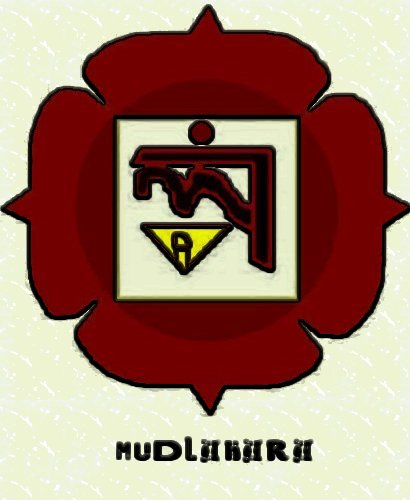
| chakra | situation | number of petals | regnant tattva and its qualities | color |
| Muladhara | Spinal center of region below the genitals | 4 | Prthivi; cohesion, stimulating sense of smell | yellow |
| Svadhisthana | Spinal center of region above the genitals | 6 | Ap; contraction, stimulating sense of taste | white |
| Manipura | Spinal center of region of the navel | 10 | Tejas; expansion, producing heat and stimulating sight-sense of color and form | red |
| Anahata | Spinal center of region of the heart | 12 | Vayu; general movement, stimulating sense of touch | smoky |
| Visuddha | Spinal center of region of the throat | 16 | Akasa; space-giving, stimulation sense of hearing | white |
| Ajna | Center of region between the eyebrows | 2 | Manas (mental faculties) | ... |
| Above the Ajna is the causal region and the Lotus of a thousand petals with all the qualities, wherein is the abode of the Supreme Bindu Parasiva. | ||||
| Shape of the mandala | Bija and its Vahana (carrier) | Devata and its Vahana | Shakti of the Dhatu | Linga and Yoni | Other Tattvas here dissolved |
| square | Lam on the Airavata elephant | Brahma on Hamsa | Dakini | Svayam-bhu and Traipura-Trikona | Gandha (smell) Tattva; smell (organ of sensation); feet (organ of action) |
| crescent | Vam on Makara | Vishnu on Garuda | Takini | ... | Rasa (taste) Tattva; taste (organ of sensation); hand (organ of action) |
| triangle | Ram on a ram | Rudra on a bull | Lakini | ... | Rupa (form and color; sight) Tattva; sight (organ of sensation); anus (organ of action) |
| six-pointed hexagon | Yam on an antelope | Isa | Kakini | Bana and Trikona | Sparsa (touch and feel) Tattva; touch (organ of sensation); penis (organ of action) |
| circle | Ham on a white elephant | Sadasiva | Sakini | ... | Sada (sound) Tattva; hearing (organ of sensation); mouth (organ of action) |
| ... | Om | Sambhu | Hakini | Itara and Trikona | Mahar, the Suksma Prakrti called Hiranyagarbha |
The yogi who has attained complete mastery over the technique of breathing and who has been able by this means to isolate himself totally from the external world, succeeds in "seeing" the interior of his body or, in other words acquires intuitive knowledge of the secret mandala that his subtle body forms. Having unraveled the tangled web of the nadis, he reaches the end of initiation and penetrates to the most inward part of himself, at the base of the trunk, where there is a cave located at the foot of the cosmic mountain. In this cave the yogi perceives three things: a fire of glowing embers, a sleeping serpent, and the threefold orifice of the three principal channels, the ida, the pingala, and the sushuma:
To succeed in this task the yogi will need to summon up all the strength he has at his command since yoga has enabled him to reach the stage at which he can practice dhyana (transcendental meditation). Taking up the yoga position he has personally found most suitable (usually the siddha-asana or "position of perfection"), he closes the windows of his body one by one (in other words achieves pratyahara or "sense withdrawl" and concentrates all his attention on a single point (dharana). At this point his mental activity is totally suspended, and the buddhi (intelligence), reflecting the light of the atman, takes over. Illuminated in this way, the yogi's supraconscious will (i.e., the intellectual vitality of the buddhi as opposed to the manas, which has been "dissolved" by dharana) is directed upon the breath inhaled and retained in pranayama. Guided in this way, the breath (prana) is conveyed down to the base of the trunk and introduced via either the ida or the pingala into the cave where the kundalini lies coiled
The entry of the prana produces an abrupt animation of the fire in the cave: the embers blossom into flame and the god Agni (Fire) brightens into splendor. The heat, the brightness, and the roar of the now flaming fire combine to waken the serpent at least from its torpor
The other interesting point brought out by this quotation is the mention of the first center of the subtle body, the muladhara. And it is now time in fact to explain that the internal mandala--consisting, as we have seen, of a vast number of nadis (rivers, channels) forming a complex network--also comprises a series of geometrical figures, seven in number, spaced out along a vertical axis running from the base of the trunk up to the top of the head. These figures are usually called chakras, a Sanskrit word that has the primary meaning of "wheel" (of a chariot) but can be used more broadly to denote any circular object, such as a disk, a potter's wheel, a cyclic period, and so on. The universe itself, for instance, is an immense chakra (that cosmic wheel) that revolves eternally around a hub (brahman). All the chakras within the subtle body are therefore primarily circles, whatever other geometrical figures they may have inscribed within those circles. Moreover, these centers are also referred to as lotuses (padma), but it must be remembered that all stylized representations of the lotus in Indian iconography are based on the circle (surrounded by a variable number of petals), except of course when the flower has not yet opened (the lotus bud, often used as a symbol of virtuality awaiting realization). In fact this iconographic stylization is often taken so far that one is unsure whether to recognize certain figures as a wheel or as a lotus. The average Indian is not at all sure whether the symbol that appears on his national flag is a lotus or a wheel, and from his point of view it does not matter much, since the symbolism is the same: that circular structure with its radiating beams is beyond doubt an image of dharma.
Obviously the seven chakras are precisely located within the subtle body, and by analogy with the gross body they are said to be situated at the same height as such and such an organ. But I must emphasize yet again that the chakras must not be thought of as coincident with any part of the gross body; they are superimposed images indicating the confluent points of particular vital forces, the activity of which sets the forces of the gross body in motion, but which remain substantially distinct from them (they subsist after death and contribute to the animation of the fetus at the moment of reincarnation in another body, in accordance with the laws of transmigration). It is therefore more correct to say that the seven chakras are situated "at the same latitude" as certain parts of the body. With this proviso in mind we can say that the first chakra is level with the anus; the second with the genitals; the third with the navel; the fourth with the heart; the fifth with the throat; the sixth with the forehead; the seventh with the top of the head. Here are a few more details about each one individually.

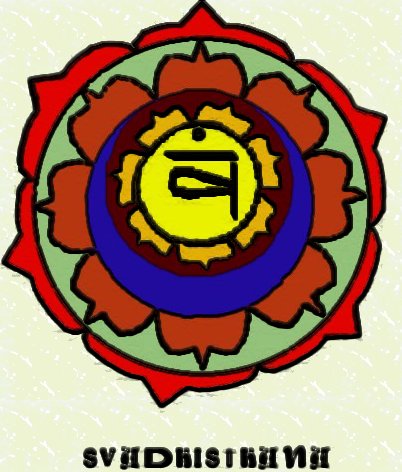
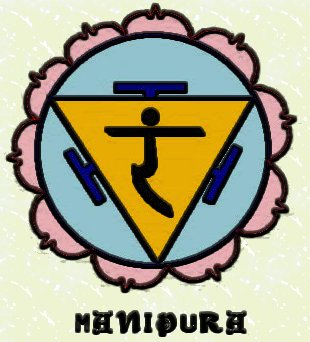
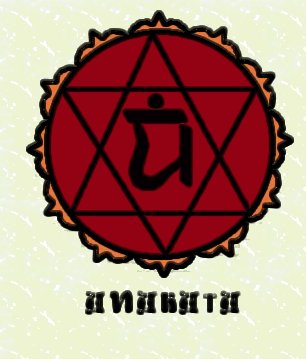
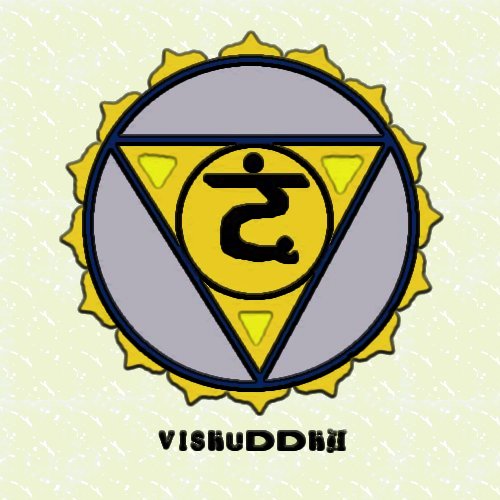

At other times (albeit less often), the texts make use of different images: they compare the chakras to
obstacles that the kundalini must "break down" or "pierce" in order to reach the seventh center.
The purpose of this approach is to stress the fact that the full realization of a virtuality is at the
same time an annihilation of it, since what is involved, at all six stages, is the transcending of that stage
so that there will be no risk of self-indulgent lingering in it and forgetting one's ultimate aim, which
is liberation. We even find it said on occasion, as a means of emphasizing the necessity for this
transcendence, that the chakras are actually Gordian knots that the yogi must cut through with
the knife of meditation.
Very little is said about the ascent itself, except that the various teachers disagree as to whether
it is slow, gradual, or rapid (or even instantaneous). The most traditional schools, following the
teaching of the Yoga-Sutras, favor the doctrine that the road is a difficult, arduous: several
attempts are needed, and many yogis will never get beyond a particular chakra. Other gurus
teach the opposite: that once the kundalini has been awakened and found the entrance to the
sushumna, she hurls herself into it and "rearing up like a snake uncoiling itself in once great leap,"
reaches the sahasrara right away (or the ajna at the very least). Knowing how far classical yoga
is a school of patience and endurance, one is inclined to favor the proponents of the arduous
path, yet there is clearly one major objection to their account: if it is true that samadhi is attained
at the moment when the kundalini reaches the top of the head, then it must follow that those
incapable of drawing it up further than the third or fourth chakra must be forever excluded from
that experience. Yet it is difficult to imagine that a yogi who has succeeded in acquiring total
mastery over his body, and in "dissolving his mind" (by means of dharana), will then prove
incapable of practicing meditation with sufficient efficacity to attain samadhi. The truth (or at
least the most widely held opinion) is to be found between these two positions: most gurus tend
to say that the road leading to sense withdrawal and perfect attention (dharana) is indeed a very
difficult one, but that once on has succeeded in awakening the kundalini, the struggle is
essentially over; the power of the serpent manifests itself in all it's strength and samadhi is
attained (the adverb "instantaneously" being nugatory here, since the experience takes place,
by definition, outside time).
In Tantric symbolism, samadhi is referred to as the beatific union of Shiva and his
shakti (the goddess Parvati). On the microcosmic level it is that of the atman (which we
must remember is a masculine word in Sanskrit) and the kundalini, an image of the eternal
marriage of purusha (spirit) and prakriti (nature). And if it is indeed true that the union knows no
end, this means that the yogi who has achieved this stage "will not return" will never again leave
his new status as a jivan-mukta (liberated-alive):
This particular coloration of samadhi is specific to Tantrism and is in conformity with the ideology
of that movement, which, as we have seen permeates the whole of modern Hinduism, despite
the claims of certain schools that they are completely separate from it. The originality here, as far
as yoga is concerned, is that great stress is laid on the contribution of sexual desire to the human
composite's motivating force. Of course all schools agree in seeing desire (kama) as the source
of the mental impregnations (vasanas) that imprison the soul in the world of phenomena; but most schools seem to
"forget," as it were, that the word kama has the primary meaning of "love" (eros). Even
the Yoga-Sutras themselves, in their list of Restraints and Disciplines, mention chastity
only once, and then only in passing, as one item among ten others, a sign that in their author's
eyes libido was no more that one manifestation, and ultimately a secondary one, of concupiscence
in general. Tantrism adopts a diametrically opposed view-point: heralding the discoveries of Freud,
it places sexual appetite at the center of personality and sees gluttony, craving for wealth, and
aggression as derivative forms of that central appetite. From this point of view it is more faithful
to the very oldest tradition that the Yoga-Sutrasare, since it is clearly not just by chance
that the term kama was selected from among all other possible ones to denote Desire
in its universal sense.
If love is indeed the motive force of the world, then its role in the sphere of existence is a
preeminent one. Ultimately, one might say that it is indistinguishable from life itself, from nature,
from prakriti as cosmic energy. In man, the microcosmic analogue of the universe, love ought similarly
to occupy a primary position, both as the determining cause of alienation (which imprisons the
individual in the world of phenomena and obliges him to continue transmigrating until the end
of the cycle) and as a power capable of liberating him, provided he acquires the necessary
intellectual knowledge of his true nature. Thus sexuality, as Nietzsche recognized long since,
involves the human being in his entirety, including the domain of spirituality so often thought
of as a separate preserve. In which case it is legitimate to make use of sexuality in order to
achieve liberation. That is what Tantrism does: taking the old adage that sin itself is a path
to salvation, it pushes it to its furthest extremes by teaching that the yogi should eat meat, drink
alcohol, and make love to prostitutes, all things forbidden by dharma to high-caste Hindus and
viewed by yoga as sins automatically canceling any spiritual progress made. Of course, such practices
have no value unless they are directed toward a higher good (salvation, liberation); otherwise
they remain sins and certainly serve no purpose (except the accumulating of negative karman).
Moreover, the yogi is not permitted to indulge in them until he has undergone his novitiate and reached
the stage of sense withdrawl (pratyahara) and perfect concentration (dharana). In other words,
these practices are intended to act as aids in the awakening of the kundalini and constitute, in a sense,
a form of transcendental meditation (dhyana). And they are also an image of the felicities awaiting
the soul (atman) when it has finally achieved liberation from the bonds of existence and is enjoying
the ecstasy of union with shakti.
The omnipresence of the sexual instinct is indicated by seals or geometric figures within the chakras.
In this context, however, sexual instinct means a multiform vital energy that can have either male
or female manifestations (and it is not the least important aspect of Tantrism that it recognizes the coexistence of both
these forms of libido within each and every being, whatever its sex). The feminine element
is symbolized, as we have seen, by a downward-pointing triangle, the masculine element
by a triangle with point uppermost, or by a representation of the moon (either crescent or circle),
or by an erect linga. This double symbolism is clearly apparent in all of the chakras except the
seventh, which is of course outside the body. The first two lotuses, for instance, include either
the triangle symbolizing the yoni (female sexual organ) or the crescent moon (symbolizing the
fertilizing power of the male sexual organ) Moving upward, the lotus at the heart level (anahata-chakra)
contains both male and female triangles interlocked. And lastly, the ajna-chakra, highest of the
"corporeal" lotuses, at the forehead level, presents the image of a full moon (male sexual power
at its fullest stage of development) enclosing a downward-pointing triangle (the female symbol),
and it is here, we are told, that the atman, which resides in this chakra, enters into union with its
shakti. The perfection of this union, in the course of which the kundalini is reabsorbed into the
atman-purusha (the soul in its male aspect) is the very symbol of love itself ("and they shall be as one flesh,
as the Gospel puts it).
The syllable om occurring within the last chakra expresses the permanence of this union,
it's perfection, and it beatific character, while also indicating that its realization will enable the
resulting "unitary couple" to attain the thousand petaled lotus (sahasrar-chakra), where, having once more become
one with essence, it will continue forever in blessed solitude (kaivalya or "isolation," the state
of the principle of all things, which, because it is one, can have no second). Practitioners of yoga explain
that this situation (the eternal marriage of spirit and nature) accounts for the name sach-chid-ananda
(being-consciousness-joy) given to the Absolute: the couple is forever, on the level of
essence, without any of the limitations of existence; it possesses full consciousness of itself
without the slightest distraction; and this full and entire knowledge it has of its eternal marriage
is in itself perfect joy or beatitude. When the yogi has attained this ultimate peace (shanti)
by returning to the principle of all things, then he has reached the goal he set himself at the
outset of his quest: the prize is won, and worth all the struggle it has cost.
All chakra images are Copyright 1998, Post Modern Psychedelia. For information about the free
use of these images click here: Free Chakra Images
The seventh and last chakra bears the name sahasrara, the thousand-rayed. It is
a simple circle of which we are told only that it radiates splendor. As a lotus it naturally has
a thousand petals, but it has no specific symbolism (color, sound, or element) connected with
it. This is easily understood if we remember that we had already reached the peak of cosmic
manifestation with the ajna-chakra: the color white, they syllable om, and the element
mahant admit nothing beyond themselves unless it be the Absolute itself, brahman/atman.
It must therefore be the Absolute itself that governs the sahasrara, and since "That" (tad) is
beyond all quality, it clearly cannot posses any color (unless it be white, which transcends all colors
by absorbing them into itself) or any sonority (om is a manifestation, a sign of brahman; it cannot
strictly speaking be brahman). To attain the sahasrara is thus to attain the "world of brahman (the
brahma-loka, in which liberation is symbolically "located"). One ought therefore to
say that this chakra is located, not "at the top of the head," but rather "above the top of the
head" in order to stress that it is differentiated from the other six. The best graphic representations,
indeed, show it in the form of an inverted lotus (stem upward, corolla opening downward)
emitting a radiance that bathes the subtle body in its entirety (rather like the aura, the golden
vesica piscis with which Byzantine iconography surrounds the body of Christ)
The role played by these centers becomes clear at the moment when the kundalini, rising
through the sushumna toward the top of the head, touches each one on her journey. The
texts are fond of saying that the lotus blossoms in the chakras are normally not more than
half-open buds; they are functioning just enough to sustain the average individual's ordinary level
of existence. For each of the chakras corresponds to a particular form of vital activity, the
muladhara presides over the sense of smell and governs the actions of arms and hands; the
manipura presides over sight and governs the excretory organs; the anahata presides over touch
and governs the sexual organs; the vishuddha is in harmony with the sense of hearing and the mouth;
the ajna with all forms of mental activity. Clearly the, the kundalini as she ascends is going to cause
the lotuses to blossom and enable their latent energies to manifest themselves with all the power
of which they are capable. This of course is the source of the miraculous powers described, which,
as it has been explained on more than one occasion, are nothing but the perfect realization or
fulfillment (siddhi) of natural virtualities, or the unfurling or blossoming (vibhuti) of those virtualities
when finally "realized."
there is the lotus with a thousand petals,
shining like the light of heaven:
it is the giver of liberation
It's secret name is Kailasa,
the mountain where Shiva dwells.
He who knows this secret place
is freed from samsara.
The latter information was obtained from "Yoga and the Hindu Tradition." The former charts
were obtained from "The Serpent Power." Full information available at the Bibliography.
email me:shiva.kali@telebot.net